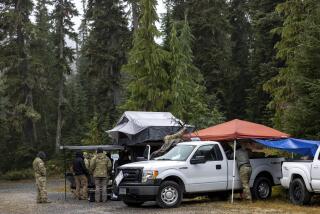Unsung Glider Veterans of World War II : ‘Silent Wings’ Want a Place in History
- Share via
LINCOLN, Neb. — They were called the silent wings. The men who flew them had a “G”--for guts--emblazoned on the silver wings they wore on their uniforms.
“The mass of Americans don’t know a thing about the gliders,” says Bard Coatsworth of Lincoln, a former state commander of the National World War II Glider Pilots Association.
“I decided it’s time that we stop sitting around telling old war stories and let the world know about the contribution of gliders to the war effort.”
Gliders owe their military history to the Germans, who were banned as part of the Versailles Treaty from manufacturing aircraft with engines, Coatsworth said.
“They used them to fly demolition experts across the lines into France at night to destroy the pillboxes and guardposts.”
Coatsworth was working at the Lincoln Aviation Institute--the same place Charles Lindbergh learned to fly--when he heard the Army was looking for experienced pilots for glider training.
He signed up in July of 1942 and wound up at Ong Flying School in Goodland, Kan., where he got 25 hours of training, landing without power from various altitudes, day and night.
From there, it was on to two air bases in Texas and more night and day dead-stick flying, with some practice in gliders made from converted power aircraft.
He got his first glimpse of the Waco CG4A (C for combat, G for glider) in Lubbock, Tex., and remembers wondering: “How could anybody fly a thing like this.”
The gilder, with a wingspan of 83 feet, 8 inches, an overall length of 48 feet, 3 3/4 inches and a height of 12 feet and 7-odd inches, “looked like a big olive green bomber,” he says.
It wasn’t designed to be pretty.
“It was an aerial truck,” Coatsworth says, “but the power pilots who criticized it didn’t know what they were missing. It handled like a dream.”
Although the war ended before Coatsworth had to fly a glider in combat, he did have some rather harrowing experiences during training.
Once the tow rope broke loose from the power aircraft pulling the glider and narrowly missed breaking the windshield of the glider. The rope became tangled around the landing gear and Coatsworth had to maneuver the craft through a clearing in some trees to land.
Snagging the rope would have resulted in a crash, he said.
On a night run, Coatsworth and his co-pilot had to cut free because they were incorrectly signaled that the tow plane was in trouble. Coatsworth and his co-pilot had a choice of landing on a highway with traffic or at a rock quarry.
“We set it down about 20 feet short of the edge of the quarry, in snake-infested country,” he says. “We spent the night on the wing until they found us in the morning.”
Coatsworth, assigned to the 66th Squadron of the 403rd Troop Carrier Group, said the CG4A could carry 13 soldiers and a crew of two. Some carried mini-bulldozers, Jeeps or mortars.
The gliders were first used in the war on July 9, 1943, when they carried British airborne troops from an airfield in Tunisia to Axis-held Sicily.
In February of 1944, gliders carried troops and equipment behind enemy lines in Burma to set up landing areas to be used in a massive air assault that surprised the Japanese.
Gliders played a key role in the D-day invasion of Normandy on June 6, 1944, and saw action in southern France, Holland, Bastogne and Varsity.
More to Read
Sign up for The Wild
We’ll help you find the best places to hike, bike and run, as well as the perfect silent spots for meditation and yoga.
You may occasionally receive promotional content from the Los Angeles Times.






